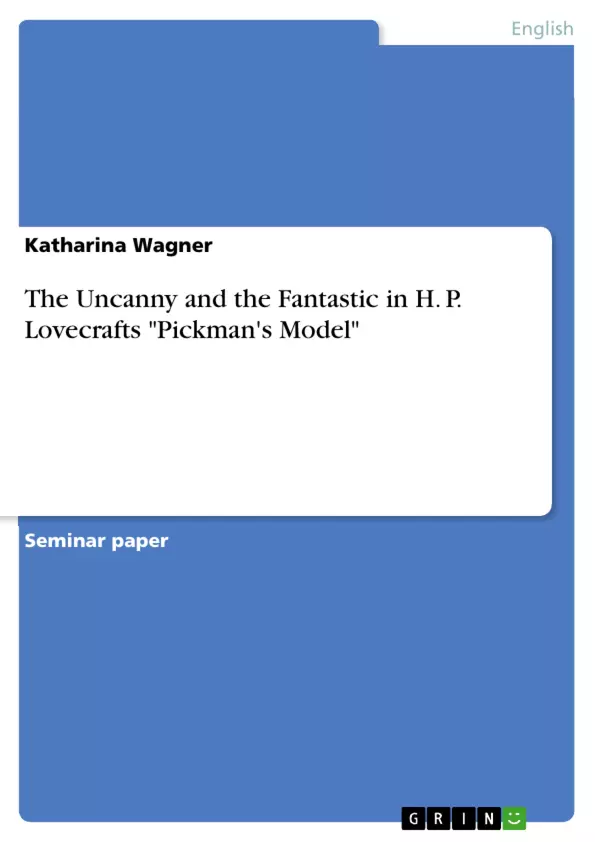One of the most influential horror writers of the early twentieth century is indeed Howard Phillips Lovecraft, born in 1890, who influenced a great number of other writers of his time and after his time. With his seeking for more than the logical everyday life, Lovecraft has become a cult figure in the horror community and for readers of supernatural fiction. Lovecraft created distinct universes filled with mythology and ancient monsters, with protagonists fighting their own demons and inner struggles. With his short story “Pickman’s Model”, published in 1926, the reader gets a fictional portrayal of the painter Pickman and the narrators report of various weird and strange happenings with the artist. On the base of this short story by Lovecraft, this paper will in the first two chapters examine the theories of Sigmund Freud’s “The Uncanny” and Tzvetan Todorov’s “The Fantastic”, their characteristics and how exactly “Pickman’s Model” applies to the theories, since both play a big role in gothic and horror literature genres. In the last chapters, this paper will work out, which literary and aesthetic effects these theories have in a text, regarding “Pickman’s Model”. With these analyses, this paper will in most terms be able to answer the questions which elements make a horror story effective, how Lovecraft’s story fits into the context of similar literary genres such as the fantastic, the uncanny and the marvelous and what makes a horror story, that is meant to evoke fear and dread in the reader, so appealing to many people, in the context of Lovecraft’s techniques.
Inhaltsverzeichnis (Table of Contents)
- Introduction: The Gothic
- Freud's Psychoanalysis
- The Uncanny
- Uncanny elements in "Pickman's Model"
- A Structural Approach
- Todorov's Theory of the Fantastic
- Fantastic and Supernatural elements in “Pickman's Model”
- Aesthetic and Narrative Effects of the Uncanny
Zielsetzung und Themenschwerpunkte (Objectives and Key Themes)
This paper examines the short story "Pickman's Model" by H. P. Lovecraft, analyzing its elements through the lens of Sigmund Freud's theory of the uncanny and Tzvetan Todorov's theory of the fantastic. The paper aims to identify and discuss the uncanny and fantastic elements within the story and explore their aesthetic and narrative effects. It aims to contribute to a deeper understanding of the nature of horror in literature, specifically in the context of Lovecraft's work.
- The uncanny in literature and its relationship to the unconscious
- The role of the fantastic in creating suspense and unsettling the reader
- The aesthetic and narrative effects of the uncanny and fantastic in Lovecraft's "Pickman's Model"
- The connection between horror and the anxieties of society
- The evolution of the horror genre and its relevance in contemporary times
Zusammenfassung der Kapitel (Chapter Summaries)
- Introduction: The Gothic: This chapter provides a brief overview of the development of the Gothic genre in literature, tracing its roots back to Horace Walpole's "The Castle of Otranto" and discussing its enduring relevance in contemporary horror. It also highlights the connection between the Gothic and societal anxieties.
- Freud's Psychoanalysis: This chapter introduces Sigmund Freud and his theory of the uncanny. It explores the concept of the uncanny, its etymological origins, and its relationship to fear, dread, and the unconscious. Freud's key points on the uncanny, including the role of repression, are discussed.
- The Uncanny: This chapter delves deeper into Freud's theory of the uncanny, examining various phenomena that contribute to its creation. It discusses the role of objects, doubles, repetition, fear of the evil eye, and death in evoking the uncanny effect.
- Uncanny elements in "Pickman's Model": This chapter analyzes the elements of Lovecraft's "Pickman's Model" that align with Freud's theory of the uncanny. It examines how the story evokes feelings of unease, dread, and the unsettling of the familiar through its depiction of the protagonist's encounters with the artist, Pickman, and his unsettling creations.
Schlüsselwörter (Keywords)
This paper explores key themes and concepts related to the Gothic genre, including horror, the uncanny, the fantastic, psychoanalysis, repression, fear, dread, and the unconscious. It examines the works of Sigmund Freud, Tzvetan Todorov, and H. P. Lovecraft, focusing on their contributions to the understanding of these concepts and their application in literary analysis. This paper also explores the relationship between the horror genre and societal anxieties, demonstrating the genre's capacity to reflect and address the fears and anxieties of different periods.
- Citation du texte
- Katharina Wagner (Auteur), 2016, The Uncanny and the Fantastic in H. P. Lovecrafts "Pickman's Model", Munich, GRIN Verlag, https://www.grin.com/document/516753



